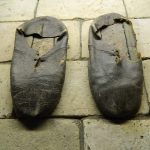150 YEARS OF THE NAZARETH SISTERS
In the footsteps of Blessed Frances Siedliska in Rome (8)
Sr. M. Beata Rudzińska, CSFN

First meeting
After a long pause, we return again to the Venice Square to begin walking in the footsteps of the third story – the history of the Congregation of the Sisters of the Holy Family of Nazareth.
Standing still in the same place, with the Vittoriano and the Fori Imperiali in front of you, you only have to turn your head back to see above the buildings the two-colored, “striped” dome of the Del Gesù Church. It is time to set out for this church, which in 1873 became a special place of prayer and encounter for Francis.
The Chiesa del Gesù (literally: Church of Jesus), or rather the Church of the Most Holy Name of Jesus, is the cradle of the Jesuits. St. Ignatius Loyola arrived in Rome at the end of 1537, eager, like Francis Siedliska three centuries later, to gain approval from the Pope for the foundation of a new order. At the threshold of the Eternal City, in the village of La Storta, he saw in a mystical vision Christ, who announced to him: “Rome will be gracious to you.” It is an interesting and little-known fact that for the first few years Ignatius and his companions lived in the present premises of the Polish Embassy to the Holy See in Via dei Delfini. It was from here that St. Francis Xavier set out to evangelize Asia. In 2014, on the occasion of the 450th anniversary of the Jesuits’ arrival in Poland, a plaque commemorating this stay was placed on the building thanks to the Embassy’s efforts.
In 1540, Pope Paul III formally approved the Society of Jesus, and a few weeks later gave them custody of the chapel of Our Lady of the Roadside (Santa Maria della Strada), which was located on the site of today’s Del Gesù Church. A religious house was built next to the chapel, where Ignatius prayed until the day of his death, wrote the Constitutions of the Order, the text of the Spiritual Exercises, and guided the rapidly growing Order (from 10 to 1,000 members during his 16 years as founder and general), often through letters, of which he wrote more than 7,000. How many parallels there are with Francis’ life as Foundress, with her room in the Motherhouse in via Machiavelli…. Worth a visit are the rooms of St. Ignatius (Camere di S. Ignazio), which have become a destination for pilgrimages and prayer since the early 17th century.
In 1873, Francis Siedliska meets one of Ignatius’ spiritual sons, Father J. Laurençot, the Jesuit assistant general for the French province, at Del Gesù. She made a confession to him, shared the task she had received from God and won him over to the cause. Fr. Laurençot is the first of many people in Rome who, attracted by Francis’ uncommon personality, help her to establish the congregation. The aforementioned Ms. Winowska, author of “The History of the Soul of Francis Siedliska,” writes of her that she has a unique gift for people, and that she attracts them like a magnet. Fr. Laurençot helps her write a request to Pius IX, hoping that “Rome will be gracious” to her as well.
And about that tomorrow…
Pictures:
Dome of the Del Gesù church – Public domain
Other pictures – Sr. Anita Jach
Plaque on the building of the Polish Embassy
Rooms of St. Ignatius
The first printed text of the Spiritual Exercises – 1548.
Signature of St. Ignatius
St. Ignatius’ shoes







